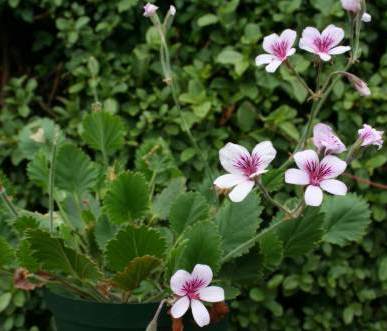Pelargonium elegans
Pelargonium elegans (Andrews) Willd.
Family: Geraniaceae
Common names: elegant pelargonium, stork's-bill (Eng.); malva (Afr.)
Introduction
Pelargonium elegans is one of several tufted pelargoniums that are suitable for outdoor pots.

Description
Description
Pelargonium elegans is a small tufted perennial up to 450 mm high. The stem is densely covered with old stipules. The leaves are elliptic, somewhat leathery and hard-textured with margins coarsely serrated. Flowers are pale pink to lilac with dark purple veins on the upper two petals. Flowering is from September to January.

Conservation Status
Status
Pelargonium elegans is very common and therefore has no conservation status.
Distribution and habitat
Distribution description
Pelargonium elegans is confined to coastal flats and dunes in the Hermanus, Gansbaai and Bredasdorp Districts. It also occurs at Potberg near Malgas.

Derivation of name and historical aspects
History
The genus Pelargonium derives its name from the resemblance of the shape of the fruit to the beak of a stork, pelargos in Greek. The species name elegans (Latin), means elegant and refers to the attractive appearance of the plant.
The genus Pelargonium belongs to the family Geraniaceae, a large family of 11 genera and 800 species in the subtropical and tropical world. Pelargonium occurs in S, E and NE Africa, Australia, New Zealand, St Helena, Tristan da Cunha, Madagascar and Asia. In southern Africa, 219 of the 270 species occur.
Ecology
Ecology
The seed of Pelargonium is quite interesting: attached to the elliptically shaped seed, is a feathered, tail-like structure that is coiled in a spiral. The tail allows the seed to drill and secure itself in the soil if twisted around by the wind or by the movement of animals.
Uses
Use
No cultural uses have been recorded. Pelargonium elegans is ideal for any coastal garden that has sandy soil conditions. It can be planted among smaller herbaceous border plants in a garden bed. It is also suited for container gardening and flower boxes.
Growing Pelargonium elegans
Grow
This plant species is easy to grow from cuttings. Cuttings can be taken during any time of the year. Soft, herbaceous stem cuttings should be taken and a rooting hormone applied, to stimulate the rooting process. The cuttings should be rooted in a cold frame, in a well-drained medium such as coarse river sand. Rooting will take place within four weeks. Once rooted, the cuttings should be potted in a well-drained potting soil.
Sow the seed in a well-drained potting soil. Broadcast the seeds evenly in the seed tray, covering them with a layer of clean, white sand or fine milled pine bark. The depth of sowing is usually one-and-a-half times the size of the seed. Water thoroughly but gently and provide light shade. Germination usually takes place within three weeks. Pelargoniums grown from seed are generally more vigorous than those grown from cuttings; however, they take longer to flower.
References
- Goldblatt, P. & Manning, J. 2000. Cape plants. A conspectus of the Cape flora of South Africa. Strelitzia 9. National Botanical Institute, Cape Town and Missouri Botanical Garden.
- Van der Walt, J.J. 1977. Pelargoniums of southern Africa. Purnell, Cape Town.
Credits
Trevor Adams
Kirstenbosch National Botanical Garden
February 2007
Plant Attributes:
Plant Type: Perennial
SA Distribution: Eastern Cape, Western Cape
Soil type: Sandy
Flowering season: Spring, Early Summer
PH: Acid, Neutral
Flower colour: Pink
Aspect: Full Sun
Gardening skill: Average
Special Features:
Horticultural zones








Rate this article
Article well written and informative
Rate this plant
Is this an interesting plant?
Login to add your Comment
Back to topNot registered yet? Click here to register.